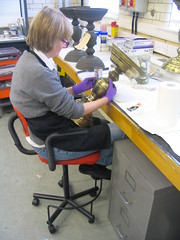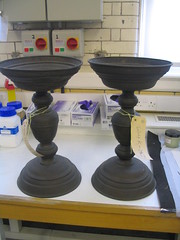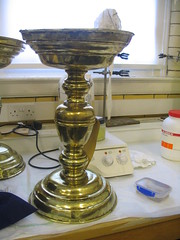By Stuart Frost
I think most visitors would be staggered by the amount of work that is involved in pulling together museum displays. When visitors walk around a successful new exhibition or display I’d hope that they’re completely absorbed with looking at the objects within them, rather than thinking about what has gone on behind the scenes. It is probably only when displays don’t work that visitors begin to contemplate the processes that the exhibition team have gone through to get to that point! 
I wrote about the choir screen (or roodloft) from ‘s-Hertogenbosch earlier this year. If you go back to the blog entries posted in February and March you’ll find pictures that give a good impression of the scale and complexity of this vast architectural piece. Room 50 has been closed to the public for sometime now. The large number of objects that were once in Room 50 have now been removed altogether. A few, like the choir screen, remain where they have always been but are now fully enclosed in protective hoarding.
 The choir screen originally had ten candlesticks placed on its balustrade. These haven’t been displayed with the object for sometime but we’re keen to ensure that they are returned to their original position when the choir screen goes back on display in November 2009. In preparation for this they have been assessed by a conservator, and as a result they’ve now undergone treatment. The image to the right shows two of the candlesticks before conservation work began. Can you guess what they’re made of? There is little in this picture to indicate that they’re made of brass.
The choir screen originally had ten candlesticks placed on its balustrade. These haven’t been displayed with the object for sometime but we’re keen to ensure that they are returned to their original position when the choir screen goes back on display in November 2009. In preparation for this they have been assessed by a conservator, and as a result they’ve now undergone treatment. The image to the right shows two of the candlesticks before conservation work began. Can you guess what they’re made of? There is little in this picture to indicate that they’re made of brass.
The image below shows that the candlesticks have been transformed but there is still work to be done before the choir screen is ready for the public. Inevitably polished metal tarnishes over time. In order to minimise this natural process each candlestick will be treated with a protective coating. The candlesticks originally had plinths which were then attached to the balustrade. The original plinths weren’t acquired by the V&A and the solution used previously, shaped plaster-blocks painted black, isn’t ideal. The blocks are heavy and there is no easy way to firmly fix them to the balustrade. There is also some doubt as to whether the colour of the original marble blocks (red or black). In addition one of my colleagues, Melissa, has been sourcing black and white marble flags for a new area of flooring beneath the choir screen. The current surface comprises of modern grey concrete slabs. I’ll write more about the floor surface later.
The original plinths weren’t acquired by the V&A and the solution used previously, shaped plaster-blocks painted black, isn’t ideal. The blocks are heavy and there is no easy way to firmly fix them to the balustrade. There is also some doubt as to whether the colour of the original marble blocks (red or black). In addition one of my colleagues, Melissa, has been sourcing black and white marble flags for a new area of flooring beneath the choir screen. The current surface comprises of modern grey concrete slabs. I’ll write more about the floor surface later.
If I mention that the choirscreen is only one object of approximately 1,800 destined for the new Medieval and Renaissance Galleries I’m sure that will give you a good indication of why a gallery project on this scale takes what might seem like such a long time to develop.